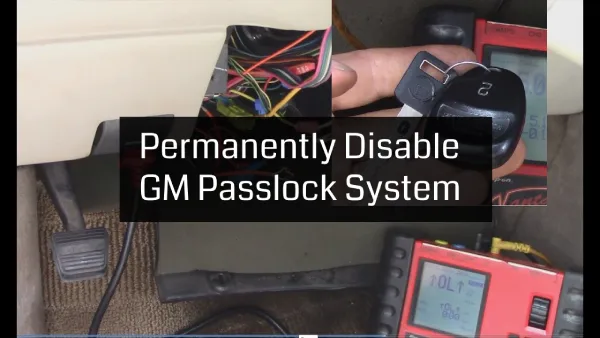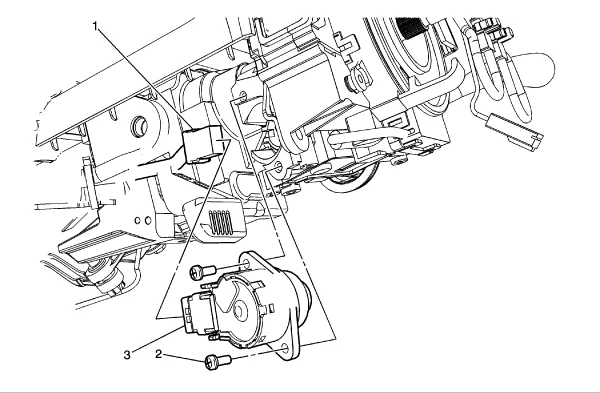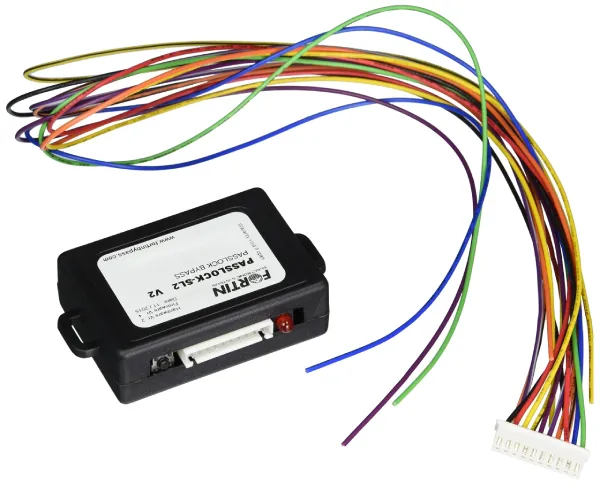The GM Passlock anti-theft system was introduced in the 1990s to deter vehicle theft. However, over time, these systems can malfunction and cause frustrating no-start conditions for owners. When operating correctly, Passlock disables fuel delivery or ignition if the correct key is not used to start the vehicle. But faulty Passlock components like the passlock sensor or control module can erroneously trigger anti-theft mode, leaving drivers stranded.
Owners faced with a malfunctioning Passlock system may choose to disable it permanently, rather than repair or replace the components. Repairs can be complicated and expensive at over $200 just for a new Passlock sensor. Replacing the components doesn’t always fix the problem if the control module is malfunctioning. Many owners determine the most cost-effective solution is to simply disable Passlock altogether rather than sink more money into fixing the unreliable system.

While this does come with some security tradeoffs, permanently disabling a malfunctioning Passlock system is often the best way for owners to ensure their vehicle will start reliably.
Here are some of the common issues with the GM Passlock anti-theft system:
- Faulty ignition lock cylinder – The Passlock sensor is located in the ignition lock cylinder. Over time, the electrical contacts can wear out or get damaged, causing intermittent connection issues. This leads to erroneous fault codes and engine no-start conditions.
- Broken or damaged wiring – The wires that connect the Passlock sensor to the control module can become damaged over time from normal wear and tear. This causes connection problems and Passlock faults.
- Defective control module – The Passlock control module processes the signal from the sensor and controls fuel delivery. These can fail internally and cause random stalling or no-start issues that seem to come and go.
- Intermittent electrical faults – Corrosion or loose connections can cause random electrical faults that confuse the Passlock module. This often results in a 10-15 minute wait to reset before the car will start again.
- Sensor ring damage – Forcing the ignition can damage the sensor ring inside the lock cylinder. This damages the ability of the sensor to read the resistor pellet in the key, leading to no-start conditions.
- Incompatible keys – Using an incorrect resistor key or a damaged/worn key can mean the sensor cannot properly read it. The Passlock system sees this as an invalid key and disables fuel delivery.
Related content: What Does “Battery Saver Active” Mean On GM & Chevy?
Step-by-Step Guide to Disable GM Passlock
So what steps are needed to disable the Passlock? Grab your tools and let’s get dirty!
Locate Passlock Components
The first step is to locate the two main components of the Passlock system – the Passlock sensor and the Passlock control module. The sensor is located on the ignition lock cylinder, usually on the upper rear area. The control module is located under the dash, often above the pedals. Refer to your vehicle’s service manual for exact locations.

Bypass Sensor
With the sensor located, unplug the electrical connector. This will disable the sensor from sending the resistive signal to the control module. To mimic the sensor, you’ll need to install a resistor that matches your vehicle’s Passlock resistance value. This resistor can be wired in place of the sensor or installed into the connector.

Reset Control Module
With the sensor bypassed, you’ll need to do an ignition switch on-off sequence to reset the Passlock control module to accept the resistor and disable anti-theft mode. Turn the key to Run for 10 minutes until the security light shuts off. Turn the key to Off for 5 seconds. Then attempt to start the vehicle.
Test Operation
Finally, test operation by attempting to start the vehicle. It should now start without any Passlock errors or waiting periods. Drive the vehicle to confirm normal operation. If it does not start, double check your resistor value and connections. With Passlock permanently disabled, your GM vehicle should now start reliably.
Tools Needed to Disable the GM Passlock System
Here are some of the key tools needed to disable the GM Passlock anti-theft system:
- Wire cutters/strippers – To cut and strip wires when bypassing the Passlock sensor
- Soldering iron – To solder connections for the resistor bypass
- Digital multimeter – For testing resistor values and electrical circuits
- Crimp connectors – To securely connect the resistor to wiring
- Electrical tape – To insulate and weatherproof soldered/crimped connections
- Trim removal tools – To access the Passlock sensor and wiring under the steering column
- Wiring schematic – To properly identify Passlock sensor and control module wires
- Resistors – The specific resistance value needed depends on the vehicle, usually 1.5-3.3 kohms
The key tools are a means to cut, strip, and connect wires to install the resistor that bypasses the Passlock sensor. A multimeter helps determine the proper resistor value. Trim tools provide access to the sensor wiring. A wiring diagram ensures working on the correct wires.
Costs Of Disabling the GM Passlock System
Here is a table outlining the potential costs of disabling the GM Passlock system, along with a summary paragraph:
| Method | Cost |
|---|---|
| Bypass module | $20-50 for the module |
| Replace lock cylinder | $80+ for new cylinder |
| Replace control module | $200+ for a new BCM |
| Professional install | $100-200 for labor |
Disabling the Passlock system can be done very cheaply with a simple bypass module costing $20-50. However, some methods, like replacing components, can run over $200 in parts alone. Paying a professional for installation will add $100-200 in labor costs. While do-it-yourself methods using a bypass module are the cheapest option, they require electrical skills.
In some cases, spending more for professional installation may be worthwhile to ensure proper disabling of Passlock. Overall costs can range from less than $50 for a DIY bypass install up to $400+ if paying for new components and professional service.
Risks Of Disabling the GM Passlock System
There are some potential risks to disabling the GM Passlock anti-theft system that should be considered:
- Vehicle theft – Bypassing Passlock removes a layer of theft deterrence, which could make the vehicle more vulnerable to theft. Though not foolproof, Passlock provides some protection.
- Insurance issues – Some insurance companies may consider a disabled Passlock system to increase theft risk. This could potentially affect insurance rates or coverage, so is better to check with your provider.
- Resale value – Disabling security features like Passlock could negatively impact resale value. Many buyers want functioning anti-theft systems.
- Erroneous fault codes – The engine computer may log fault codes for Passlock being disabled. This could complicate troubleshooting other issues down the road.
- Loss of warranty – GM’s factory warranty generally does not cover disabling or bypassing the Passlock system. Any related repairs may not be covered.
- DIY risks – Improper bypassing of the system could lead to other electrical issues or failure to disable Passlock fully.
Overall, the risks seem relatively low compared to the no-start issues a malfunctioning Passlock can cause. But it’s smart to be aware of the potential downsides before disabling the system.
How to identify if my car has the GM Passlock system?
Here are a few ways to identify if your car has the GM Passlock anti-theft system:
- Check your keys – Passlock uses keys with a resistor pellet or magnet embedded in them. If your key has a black or gray plastic head with “PK3” stamped on it, your car likely has Passlock.
- Look for a security light – Most GM cars with Passlock have a “security” or “anti-theft” light on the dash. It comes on briefly when starting and indicates the status of the system.
- Check under the steering column – You can visually inspect to see if there is a Passlock sensor installed around the ignition cylinder. It will have a wiring connector.
- Check service records – If you’re not the original owner, service records may indicate if Passlock components have been replaced. Dealers can also check the VIN to see if Passlock was installed at the factory.
- Try to start it – If the engine cranks but won’t start, then the security light flashes, it’s a sign Passlock may be activating and preventing starting. This could indicate the system is present.
FAQ
Is it legal to disable the Passlock system on my GM?
At the moment of writing this article, there are no specific laws prohibiting drivers from disabling the Passlock system.
Can disabling the Passlock system void the car’s warranty?
GM can technically void the factory warranty if the Passlock system is disabled or bypassed, since that would involve modifying an integral security system.
What are the benefits of disabling the Passlock system?
The benefits of disabling the GM Passlock anti-theft system mainly revolve around addressing the issues caused by a malfunctioning system. When the Passlock system malfunctions, it can prevent vehicles from starting, causing inconvenience and potential safety hazards.
Can disabling the Passlock system cause damage to the car?
Disabling the Passlock system itself should not cause damage to the car. However, there are potential risks and consequences associated with disabling the system (discussed above).
Sources
GM Passlock I & II Information
GM Vehicle Theft Deterrent (VTD) Relearn Procedures
Every since I was a little boy, I can remember spending the afternoons in my dad’s repair shop. I got my first car at 16 and it was the best feeling ever!
I have contributed to various automotive publications but decided it’s finally time to settle for something constant.








